Financial Decision Making Report: BM 414 for Panini Limited Analysis
VerifiedAdded on 2023/06/10
|12
|3727
|69
Report
AI Summary
This report analyzes the financial decision-making processes of Panini Limited, a medium-sized bread manufacturing company. Task 1 explores the roles of accounting and finance departments, including financial accounting, management accounting, tax, auditing, investment, financing, dividend, and working capital functions. It also details the sources of finance available to the company, such as retained earnings, equity, and debt. Task 2 involves a comprehensive ratio analysis, calculating and interpreting eight key financial ratios: gross profit margin, operating profit margin, return on capital employed (ROCE), current ratio, quick ratio, inventory turnover, debtor’s collection period, and creditor’s collection period. The analysis includes comparisons between 2018 and 2019 figures, reasons for changes, and suggestions for improvement, providing insights into the company's financial performance and areas for potential enhancement.
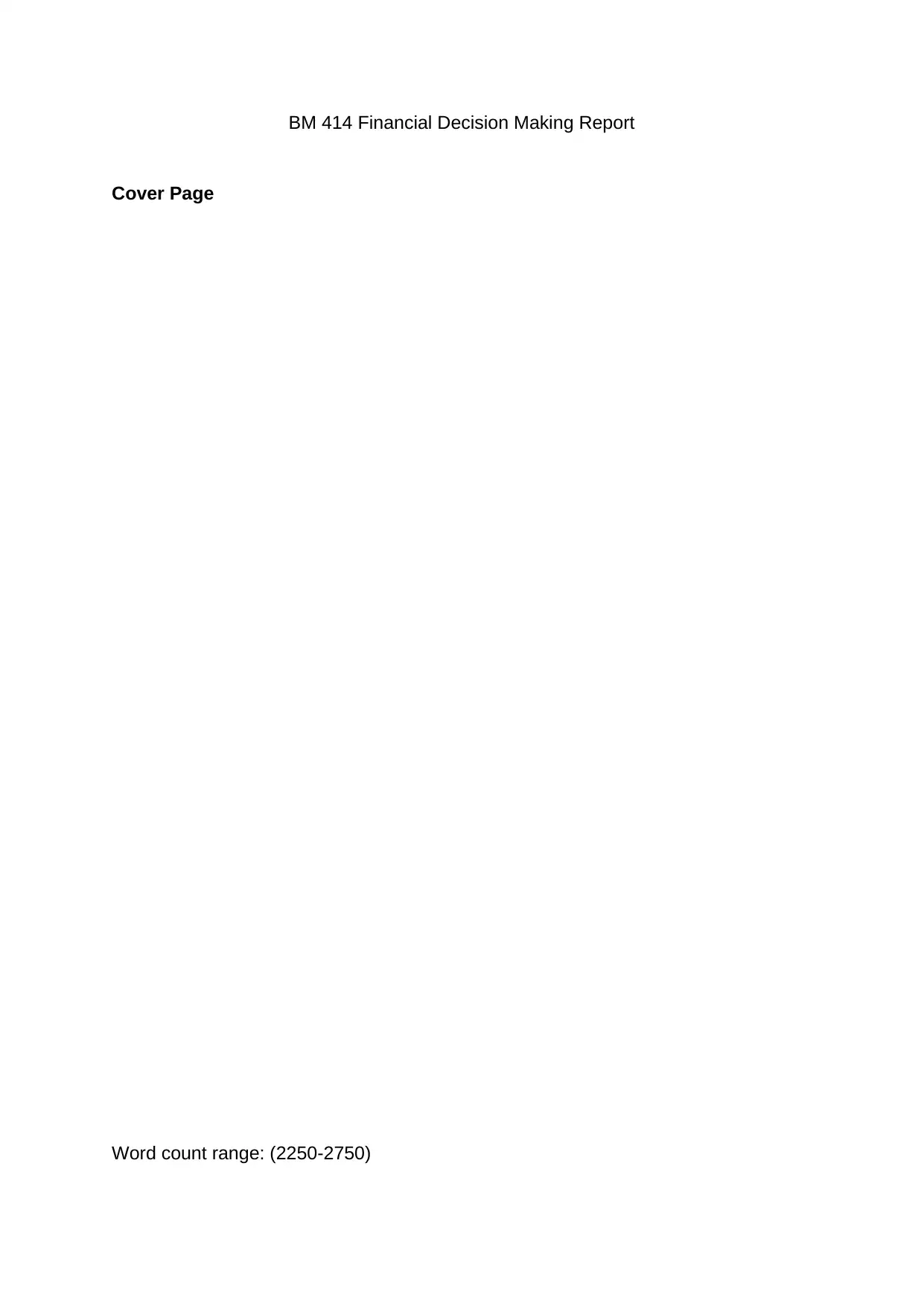
BM 414 Financial Decision Making Report
Cover Page
Word count range: (2250-2750)
Cover Page
Word count range: (2250-2750)
Paraphrase This Document
Need a fresh take? Get an instant paraphrase of this document with our AI Paraphraser
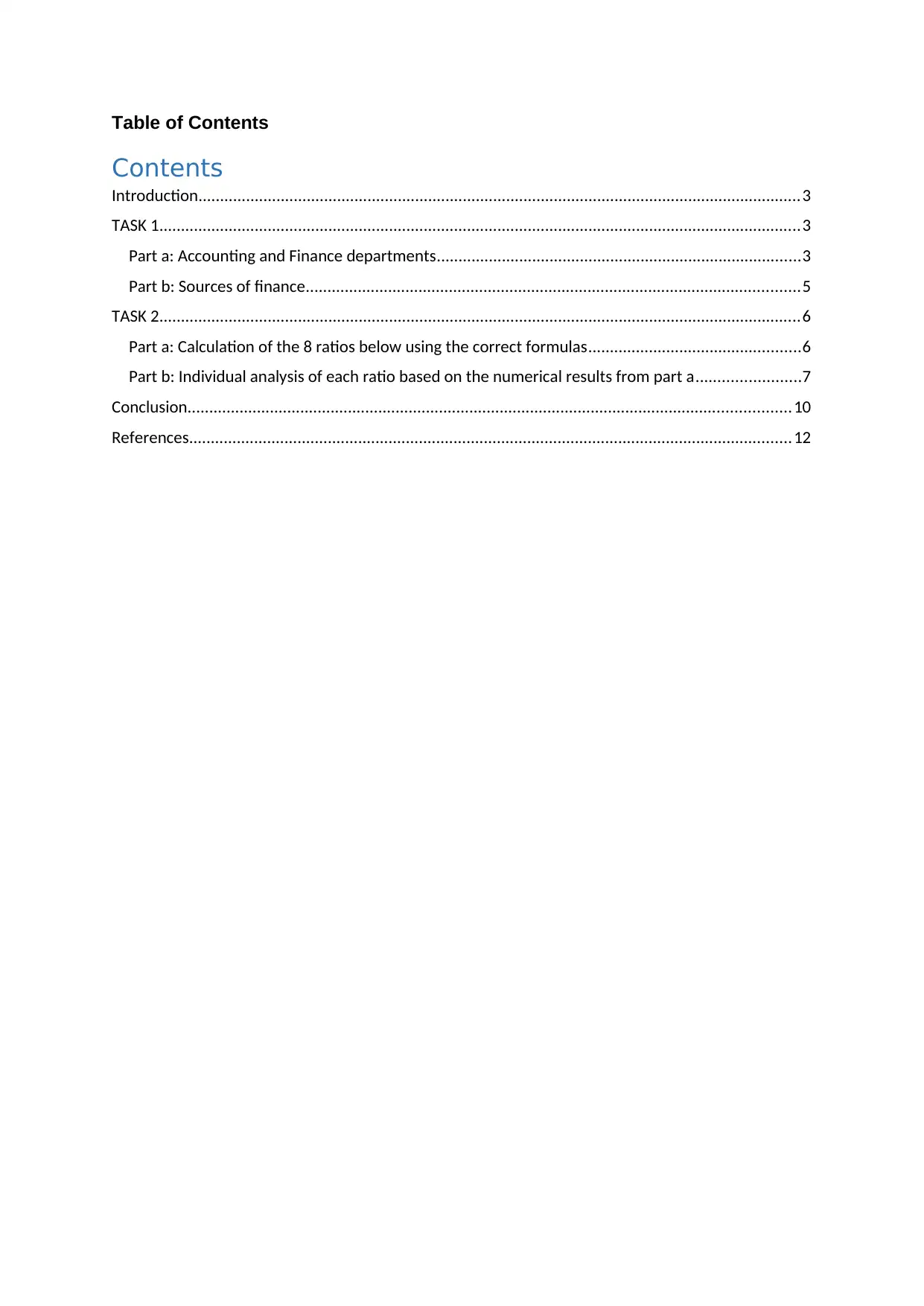
Table of Contents
Contents
Introduction...........................................................................................................................................3
TASK 1....................................................................................................................................................3
Part a: Accounting and Finance departments....................................................................................3
Part b: Sources of finance..................................................................................................................5
TASK 2....................................................................................................................................................6
Part a: Calculation of the 8 ratios below using the correct formulas.................................................6
Part b: Individual analysis of each ratio based on the numerical results from part a........................7
Conclusion...........................................................................................................................................10
References...........................................................................................................................................12
Contents
Introduction...........................................................................................................................................3
TASK 1....................................................................................................................................................3
Part a: Accounting and Finance departments....................................................................................3
Part b: Sources of finance..................................................................................................................5
TASK 2....................................................................................................................................................6
Part a: Calculation of the 8 ratios below using the correct formulas.................................................6
Part b: Individual analysis of each ratio based on the numerical results from part a........................7
Conclusion...........................................................................................................................................10
References...........................................................................................................................................12
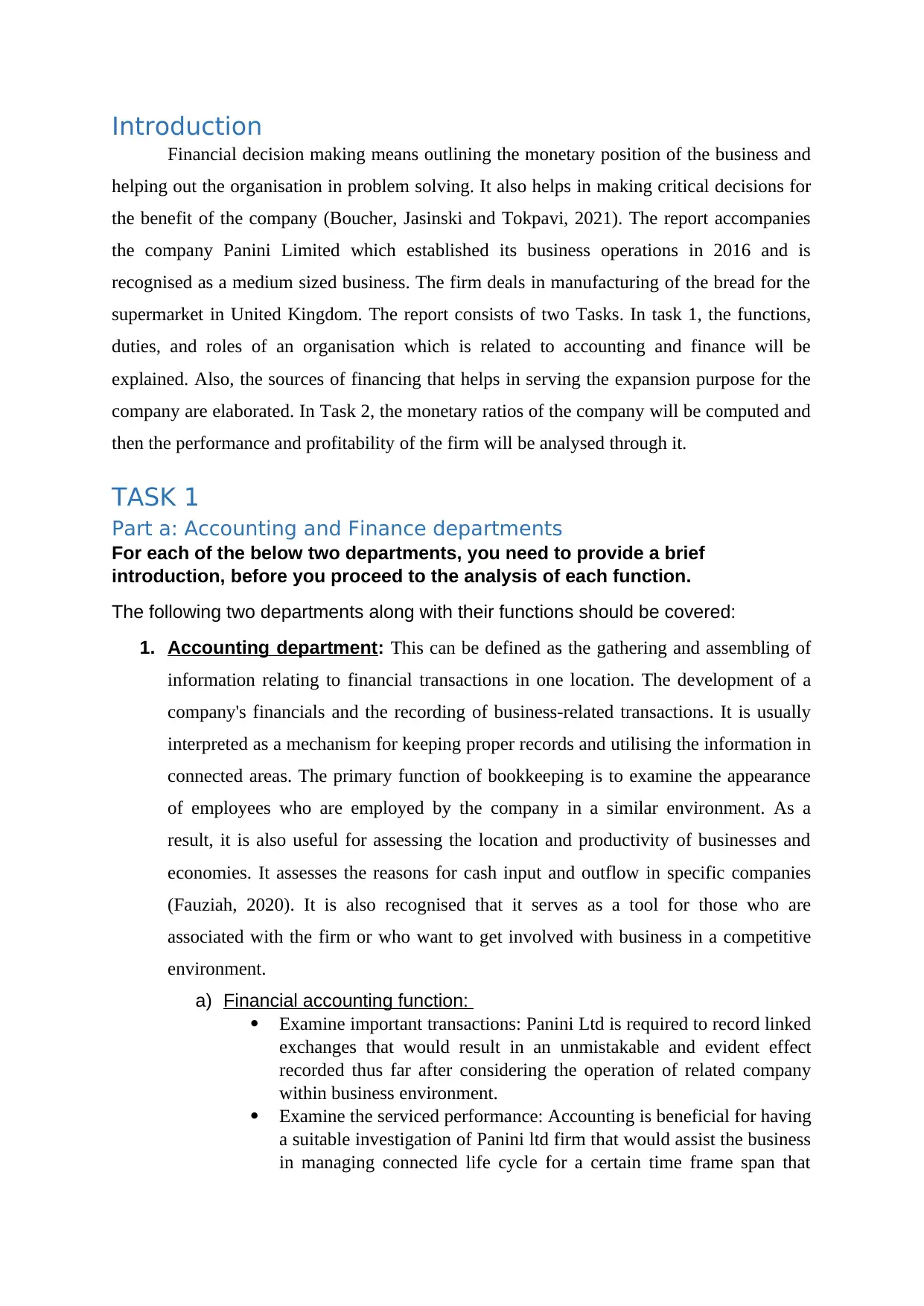
Introduction
Financial decision making means outlining the monetary position of the business and
helping out the organisation in problem solving. It also helps in making critical decisions for
the benefit of the company (Boucher, Jasinski and Tokpavi, 2021). The report accompanies
the company Panini Limited which established its business operations in 2016 and is
recognised as a medium sized business. The firm deals in manufacturing of the bread for the
supermarket in United Kingdom. The report consists of two Tasks. In task 1, the functions,
duties, and roles of an organisation which is related to accounting and finance will be
explained. Also, the sources of financing that helps in serving the expansion purpose for the
company are elaborated. In Task 2, the monetary ratios of the company will be computed and
then the performance and profitability of the firm will be analysed through it.
TASK 1
Part a: Accounting and Finance departments
For each of the below two departments, you need to provide a brief
introduction, before you proceed to the analysis of each function.
The following two departments along with their functions should be covered:
1. Accounting department: This can be defined as the gathering and assembling of
information relating to financial transactions in one location. The development of a
company's financials and the recording of business-related transactions. It is usually
interpreted as a mechanism for keeping proper records and utilising the information in
connected areas. The primary function of bookkeeping is to examine the appearance
of employees who are employed by the company in a similar environment. As a
result, it is also useful for assessing the location and productivity of businesses and
economies. It assesses the reasons for cash input and outflow in specific companies
(Fauziah, 2020). It is also recognised that it serves as a tool for those who are
associated with the firm or who want to get involved with business in a competitive
environment.
a) Financial accounting function:
Examine important transactions: Panini Ltd is required to record linked
exchanges that would result in an unmistakable and evident effect
recorded thus far after considering the operation of related company
within business environment.
Examine the serviced performance: Accounting is beneficial for having
a suitable investigation of Panini ltd firm that would assist the business
in managing connected life cycle for a certain time frame span that
Financial decision making means outlining the monetary position of the business and
helping out the organisation in problem solving. It also helps in making critical decisions for
the benefit of the company (Boucher, Jasinski and Tokpavi, 2021). The report accompanies
the company Panini Limited which established its business operations in 2016 and is
recognised as a medium sized business. The firm deals in manufacturing of the bread for the
supermarket in United Kingdom. The report consists of two Tasks. In task 1, the functions,
duties, and roles of an organisation which is related to accounting and finance will be
explained. Also, the sources of financing that helps in serving the expansion purpose for the
company are elaborated. In Task 2, the monetary ratios of the company will be computed and
then the performance and profitability of the firm will be analysed through it.
TASK 1
Part a: Accounting and Finance departments
For each of the below two departments, you need to provide a brief
introduction, before you proceed to the analysis of each function.
The following two departments along with their functions should be covered:
1. Accounting department: This can be defined as the gathering and assembling of
information relating to financial transactions in one location. The development of a
company's financials and the recording of business-related transactions. It is usually
interpreted as a mechanism for keeping proper records and utilising the information in
connected areas. The primary function of bookkeeping is to examine the appearance
of employees who are employed by the company in a similar environment. As a
result, it is also useful for assessing the location and productivity of businesses and
economies. It assesses the reasons for cash input and outflow in specific companies
(Fauziah, 2020). It is also recognised that it serves as a tool for those who are
associated with the firm or who want to get involved with business in a competitive
environment.
a) Financial accounting function:
Examine important transactions: Panini Ltd is required to record linked
exchanges that would result in an unmistakable and evident effect
recorded thus far after considering the operation of related company
within business environment.
Examine the serviced performance: Accounting is beneficial for having
a suitable investigation of Panini ltd firm that would assist the business
in managing connected life cycle for a certain time frame span that
⊘ This is a preview!⊘
Do you want full access?
Subscribe today to unlock all pages.

Trusted by 1+ million students worldwide
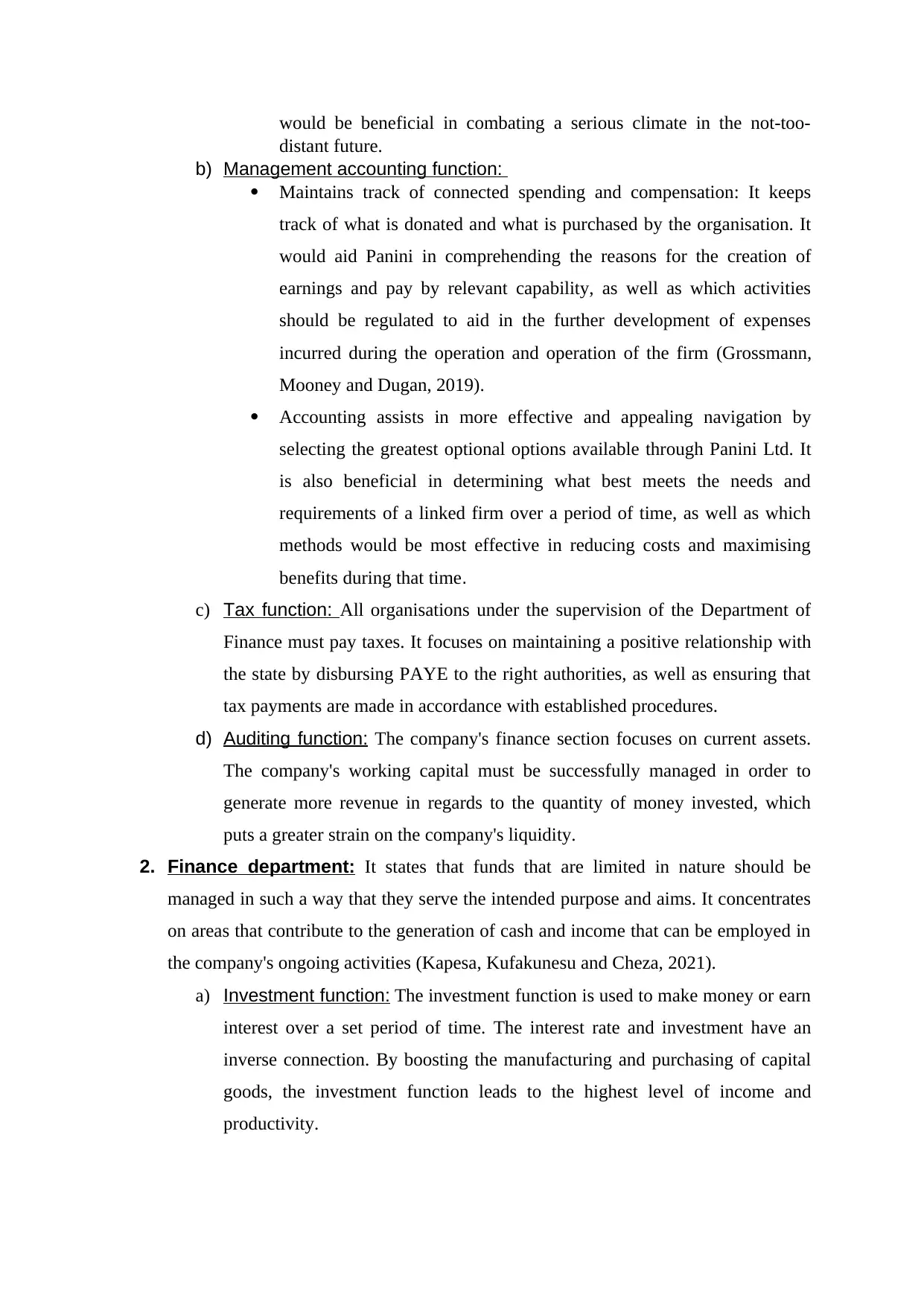
would be beneficial in combating a serious climate in the not-too-
distant future.
b) Management accounting function:
Maintains track of connected spending and compensation: It keeps
track of what is donated and what is purchased by the organisation. It
would aid Panini in comprehending the reasons for the creation of
earnings and pay by relevant capability, as well as which activities
should be regulated to aid in the further development of expenses
incurred during the operation and operation of the firm (Grossmann,
Mooney and Dugan, 2019).
Accounting assists in more effective and appealing navigation by
selecting the greatest optional options available through Panini Ltd. It
is also beneficial in determining what best meets the needs and
requirements of a linked firm over a period of time, as well as which
methods would be most effective in reducing costs and maximising
benefits during that time.
c) Tax function: All organisations under the supervision of the Department of
Finance must pay taxes. It focuses on maintaining a positive relationship with
the state by disbursing PAYE to the right authorities, as well as ensuring that
tax payments are made in accordance with established procedures.
d) Auditing function: The company's finance section focuses on current assets.
The company's working capital must be successfully managed in order to
generate more revenue in regards to the quantity of money invested, which
puts a greater strain on the company's liquidity.
2. Finance department: It states that funds that are limited in nature should be
managed in such a way that they serve the intended purpose and aims. It concentrates
on areas that contribute to the generation of cash and income that can be employed in
the company's ongoing activities (Kapesa, Kufakunesu and Cheza, 2021).
a) Investment function: The investment function is used to make money or earn
interest over a set period of time. The interest rate and investment have an
inverse connection. By boosting the manufacturing and purchasing of capital
goods, the investment function leads to the highest level of income and
productivity.
distant future.
b) Management accounting function:
Maintains track of connected spending and compensation: It keeps
track of what is donated and what is purchased by the organisation. It
would aid Panini in comprehending the reasons for the creation of
earnings and pay by relevant capability, as well as which activities
should be regulated to aid in the further development of expenses
incurred during the operation and operation of the firm (Grossmann,
Mooney and Dugan, 2019).
Accounting assists in more effective and appealing navigation by
selecting the greatest optional options available through Panini Ltd. It
is also beneficial in determining what best meets the needs and
requirements of a linked firm over a period of time, as well as which
methods would be most effective in reducing costs and maximising
benefits during that time.
c) Tax function: All organisations under the supervision of the Department of
Finance must pay taxes. It focuses on maintaining a positive relationship with
the state by disbursing PAYE to the right authorities, as well as ensuring that
tax payments are made in accordance with established procedures.
d) Auditing function: The company's finance section focuses on current assets.
The company's working capital must be successfully managed in order to
generate more revenue in regards to the quantity of money invested, which
puts a greater strain on the company's liquidity.
2. Finance department: It states that funds that are limited in nature should be
managed in such a way that they serve the intended purpose and aims. It concentrates
on areas that contribute to the generation of cash and income that can be employed in
the company's ongoing activities (Kapesa, Kufakunesu and Cheza, 2021).
a) Investment function: The investment function is used to make money or earn
interest over a set period of time. The interest rate and investment have an
inverse connection. By boosting the manufacturing and purchasing of capital
goods, the investment function leads to the highest level of income and
productivity.
Paraphrase This Document
Need a fresh take? Get an instant paraphrase of this document with our AI Paraphraser
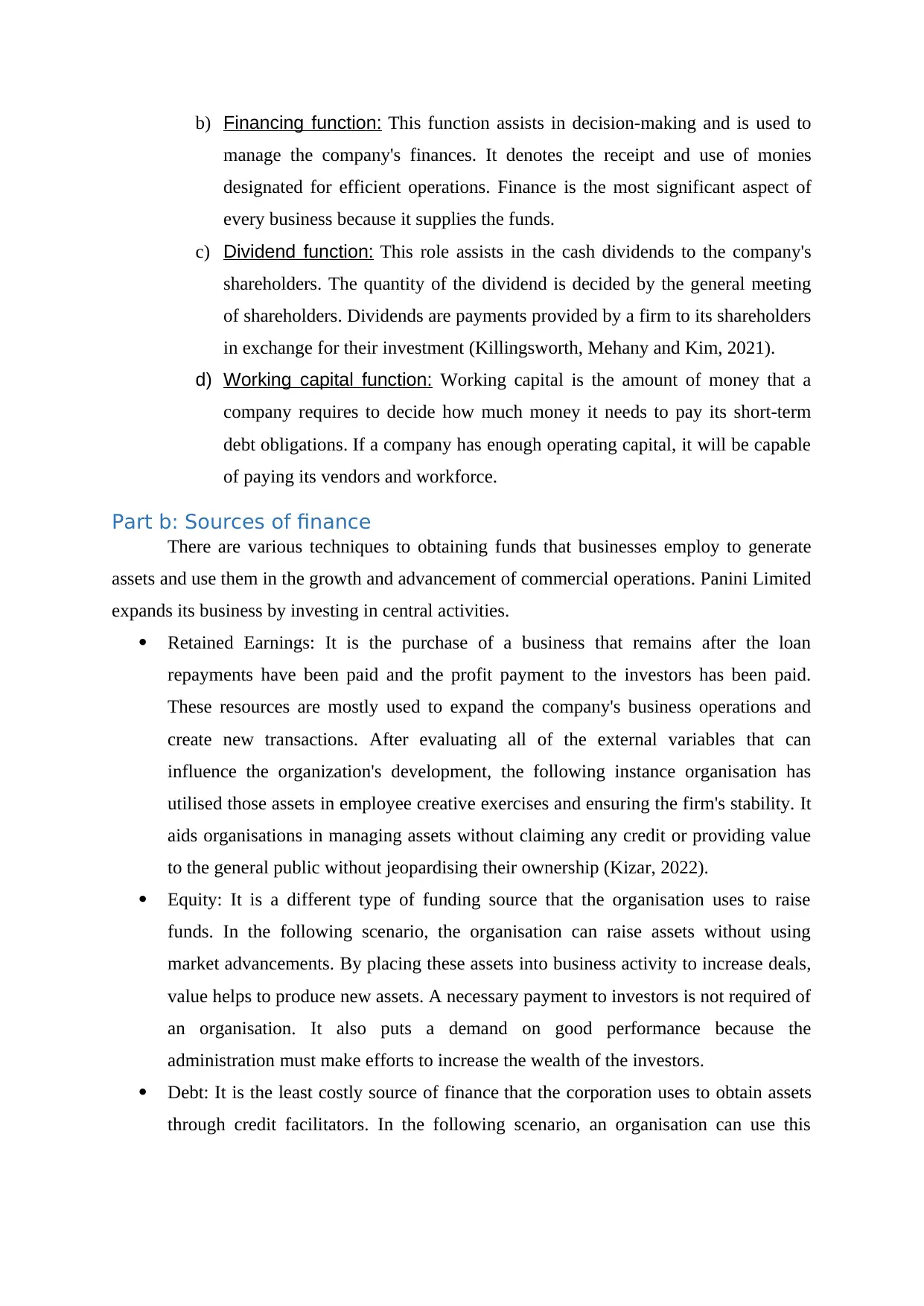
b) Financing function: This function assists in decision-making and is used to
manage the company's finances. It denotes the receipt and use of monies
designated for efficient operations. Finance is the most significant aspect of
every business because it supplies the funds.
c) Dividend function: This role assists in the cash dividends to the company's
shareholders. The quantity of the dividend is decided by the general meeting
of shareholders. Dividends are payments provided by a firm to its shareholders
in exchange for their investment (Killingsworth, Mehany and Kim, 2021).
d) Working capital function: Working capital is the amount of money that a
company requires to decide how much money it needs to pay its short-term
debt obligations. If a company has enough operating capital, it will be capable
of paying its vendors and workforce.
Part b: Sources of finance
There are various techniques to obtaining funds that businesses employ to generate
assets and use them in the growth and advancement of commercial operations. Panini Limited
expands its business by investing in central activities.
Retained Earnings: It is the purchase of a business that remains after the loan
repayments have been paid and the profit payment to the investors has been paid.
These resources are mostly used to expand the company's business operations and
create new transactions. After evaluating all of the external variables that can
influence the organization's development, the following instance organisation has
utilised those assets in employee creative exercises and ensuring the firm's stability. It
aids organisations in managing assets without claiming any credit or providing value
to the general public without jeopardising their ownership (Kizar, 2022).
Equity: It is a different type of funding source that the organisation uses to raise
funds. In the following scenario, the organisation can raise assets without using
market advancements. By placing these assets into business activity to increase deals,
value helps to produce new assets. A necessary payment to investors is not required of
an organisation. It also puts a demand on good performance because the
administration must make efforts to increase the wealth of the investors.
Debt: It is the least costly source of finance that the corporation uses to obtain assets
through credit facilitators. In the following scenario, an organisation can use this
manage the company's finances. It denotes the receipt and use of monies
designated for efficient operations. Finance is the most significant aspect of
every business because it supplies the funds.
c) Dividend function: This role assists in the cash dividends to the company's
shareholders. The quantity of the dividend is decided by the general meeting
of shareholders. Dividends are payments provided by a firm to its shareholders
in exchange for their investment (Killingsworth, Mehany and Kim, 2021).
d) Working capital function: Working capital is the amount of money that a
company requires to decide how much money it needs to pay its short-term
debt obligations. If a company has enough operating capital, it will be capable
of paying its vendors and workforce.
Part b: Sources of finance
There are various techniques to obtaining funds that businesses employ to generate
assets and use them in the growth and advancement of commercial operations. Panini Limited
expands its business by investing in central activities.
Retained Earnings: It is the purchase of a business that remains after the loan
repayments have been paid and the profit payment to the investors has been paid.
These resources are mostly used to expand the company's business operations and
create new transactions. After evaluating all of the external variables that can
influence the organization's development, the following instance organisation has
utilised those assets in employee creative exercises and ensuring the firm's stability. It
aids organisations in managing assets without claiming any credit or providing value
to the general public without jeopardising their ownership (Kizar, 2022).
Equity: It is a different type of funding source that the organisation uses to raise
funds. In the following scenario, the organisation can raise assets without using
market advancements. By placing these assets into business activity to increase deals,
value helps to produce new assets. A necessary payment to investors is not required of
an organisation. It also puts a demand on good performance because the
administration must make efforts to increase the wealth of the investors.
Debt: It is the least costly source of finance that the corporation uses to obtain assets
through credit facilitators. In the following scenario, an organisation can use this
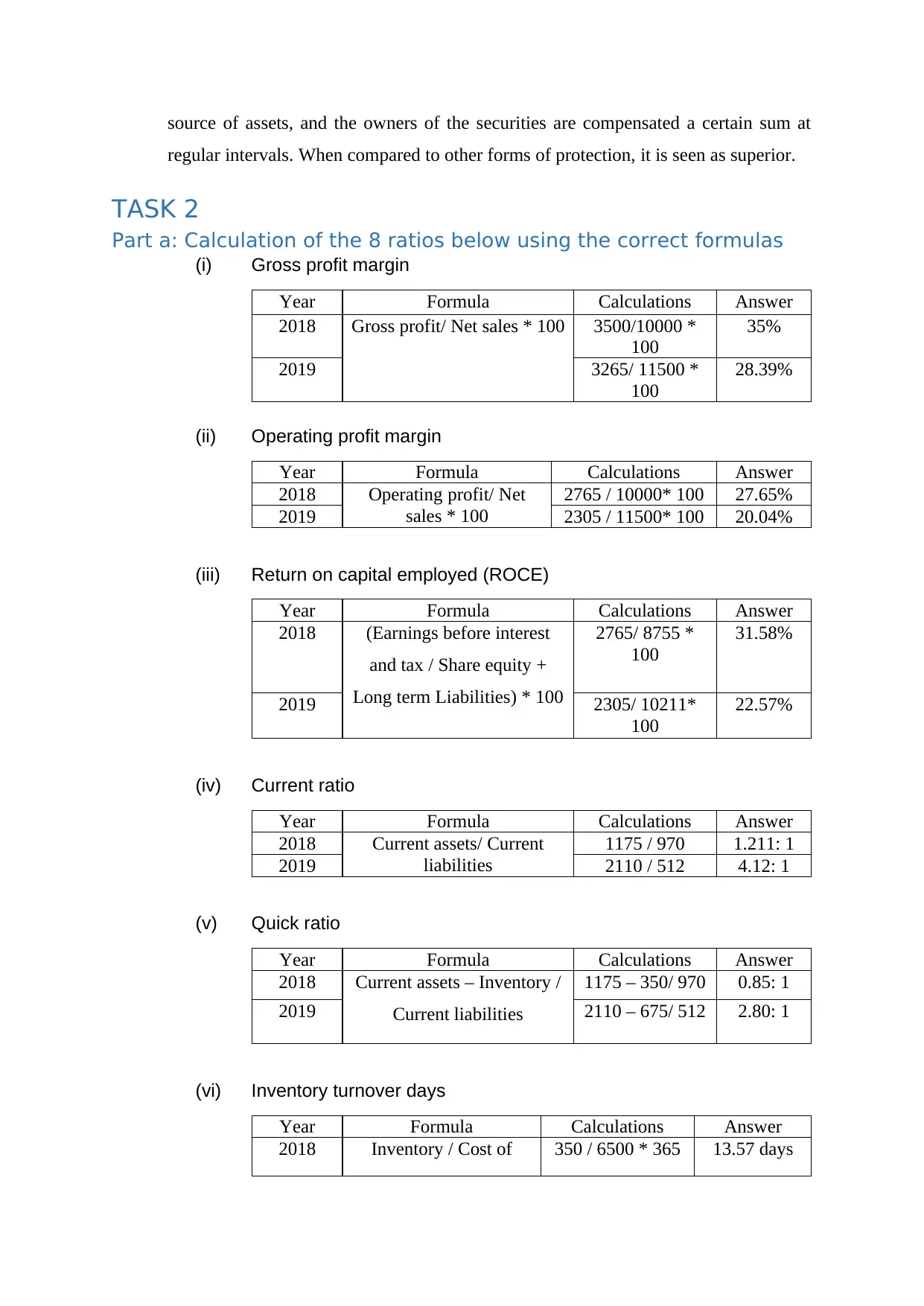
source of assets, and the owners of the securities are compensated a certain sum at
regular intervals. When compared to other forms of protection, it is seen as superior.
TASK 2
Part a: Calculation of the 8 ratios below using the correct formulas
(i) Gross profit margin
Year Formula Calculations Answer
2018 Gross profit/ Net sales * 100 3500/10000 *
100
35%
2019 3265/ 11500 *
100
28.39%
(ii) Operating profit margin
Year Formula Calculations Answer
2018 Operating profit/ Net
sales * 100
2765 / 10000* 100 27.65%
2019 2305 / 11500* 100 20.04%
(iii) Return on capital employed (ROCE)
Year Formula Calculations Answer
2018 (Earnings before interest
and tax / Share equity +
Long term Liabilities) * 100
2765/ 8755 *
100
31.58%
2019 2305/ 10211*
100
22.57%
(iv) Current ratio
Year Formula Calculations Answer
2018 Current assets/ Current
liabilities
1175 / 970 1.211: 1
2019 2110 / 512 4.12: 1
(v) Quick ratio
Year Formula Calculations Answer
2018 Current assets – Inventory /
Current liabilities
1175 – 350/ 970 0.85: 1
2019 2110 – 675/ 512 2.80: 1
(vi) Inventory turnover days
Year Formula Calculations Answer
2018 Inventory / Cost of 350 / 6500 * 365 13.57 days
regular intervals. When compared to other forms of protection, it is seen as superior.
TASK 2
Part a: Calculation of the 8 ratios below using the correct formulas
(i) Gross profit margin
Year Formula Calculations Answer
2018 Gross profit/ Net sales * 100 3500/10000 *
100
35%
2019 3265/ 11500 *
100
28.39%
(ii) Operating profit margin
Year Formula Calculations Answer
2018 Operating profit/ Net
sales * 100
2765 / 10000* 100 27.65%
2019 2305 / 11500* 100 20.04%
(iii) Return on capital employed (ROCE)
Year Formula Calculations Answer
2018 (Earnings before interest
and tax / Share equity +
Long term Liabilities) * 100
2765/ 8755 *
100
31.58%
2019 2305/ 10211*
100
22.57%
(iv) Current ratio
Year Formula Calculations Answer
2018 Current assets/ Current
liabilities
1175 / 970 1.211: 1
2019 2110 / 512 4.12: 1
(v) Quick ratio
Year Formula Calculations Answer
2018 Current assets – Inventory /
Current liabilities
1175 – 350/ 970 0.85: 1
2019 2110 – 675/ 512 2.80: 1
(vi) Inventory turnover days
Year Formula Calculations Answer
2018 Inventory / Cost of 350 / 6500 * 365 13.57 days
⊘ This is a preview!⊘
Do you want full access?
Subscribe today to unlock all pages.

Trusted by 1+ million students worldwide
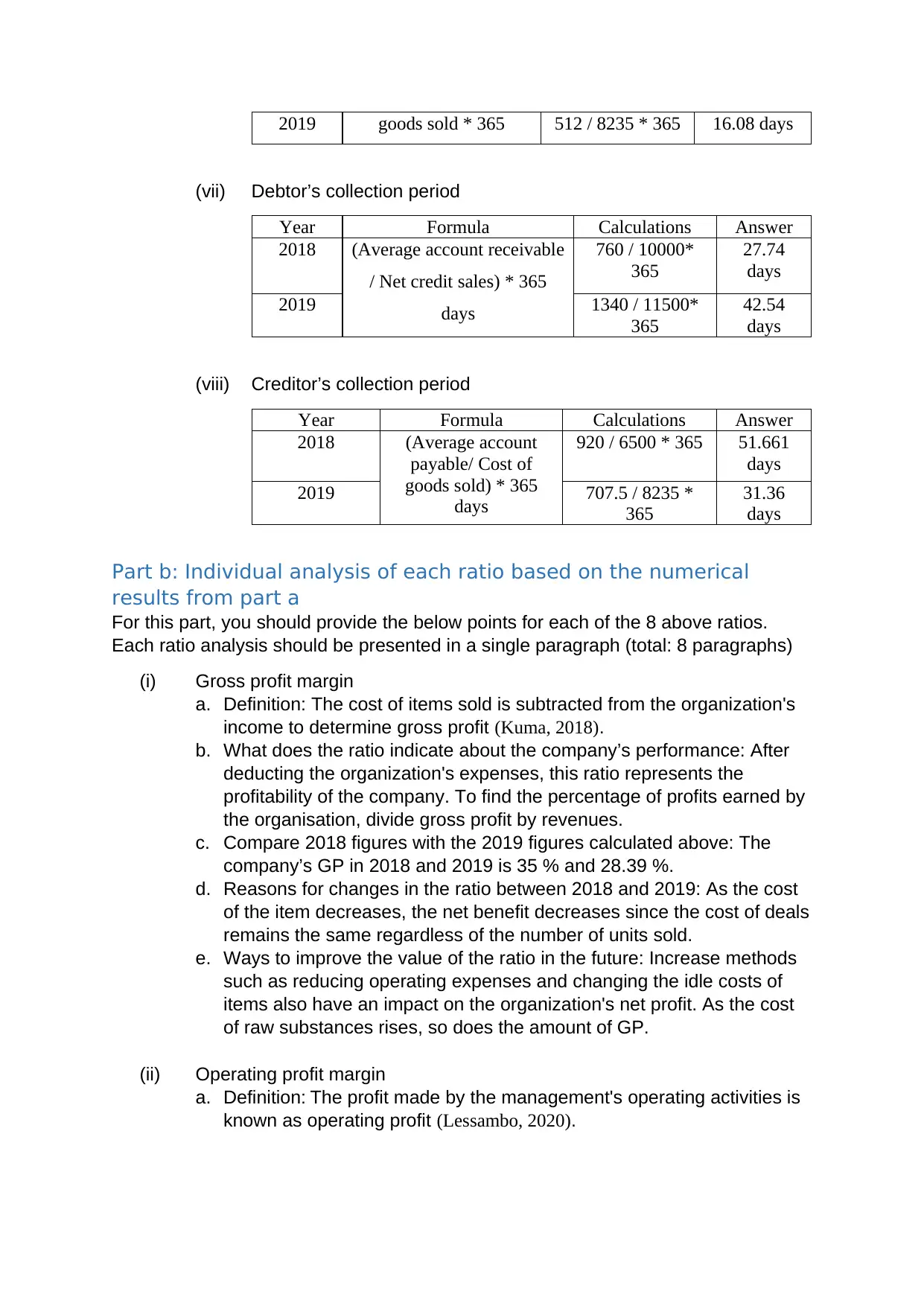
goods sold * 3652019 512 / 8235 * 365 16.08 days
(vii) Debtor’s collection period
Year Formula Calculations Answer
2018 (Average account receivable
/ Net credit sales) * 365
days
760 / 10000*
365
27.74
days
2019 1340 / 11500*
365
42.54
days
(viii) Creditor’s collection period
Year Formula Calculations Answer
2018 (Average account
payable/ Cost of
goods sold) * 365
days
920 / 6500 * 365 51.661
days
2019 707.5 / 8235 *
365
31.36
days
Part b: Individual analysis of each ratio based on the numerical
results from part a
For this part, you should provide the below points for each of the 8 above ratios.
Each ratio analysis should be presented in a single paragraph (total: 8 paragraphs)
(i) Gross profit margin
a. Definition: The cost of items sold is subtracted from the organization's
income to determine gross profit (Kuma, 2018).
b. What does the ratio indicate about the company’s performance: After
deducting the organization's expenses, this ratio represents the
profitability of the company. To find the percentage of profits earned by
the organisation, divide gross profit by revenues.
c. Compare 2018 figures with the 2019 figures calculated above: The
company’s GP in 2018 and 2019 is 35 % and 28.39 %.
d. Reasons for changes in the ratio between 2018 and 2019: As the cost
of the item decreases, the net benefit decreases since the cost of deals
remains the same regardless of the number of units sold.
e. Ways to improve the value of the ratio in the future: Increase methods
such as reducing operating expenses and changing the idle costs of
items also have an impact on the organization's net profit. As the cost
of raw substances rises, so does the amount of GP.
(ii) Operating profit margin
a. Definition: The profit made by the management's operating activities is
known as operating profit (Lessambo, 2020).
(vii) Debtor’s collection period
Year Formula Calculations Answer
2018 (Average account receivable
/ Net credit sales) * 365
days
760 / 10000*
365
27.74
days
2019 1340 / 11500*
365
42.54
days
(viii) Creditor’s collection period
Year Formula Calculations Answer
2018 (Average account
payable/ Cost of
goods sold) * 365
days
920 / 6500 * 365 51.661
days
2019 707.5 / 8235 *
365
31.36
days
Part b: Individual analysis of each ratio based on the numerical
results from part a
For this part, you should provide the below points for each of the 8 above ratios.
Each ratio analysis should be presented in a single paragraph (total: 8 paragraphs)
(i) Gross profit margin
a. Definition: The cost of items sold is subtracted from the organization's
income to determine gross profit (Kuma, 2018).
b. What does the ratio indicate about the company’s performance: After
deducting the organization's expenses, this ratio represents the
profitability of the company. To find the percentage of profits earned by
the organisation, divide gross profit by revenues.
c. Compare 2018 figures with the 2019 figures calculated above: The
company’s GP in 2018 and 2019 is 35 % and 28.39 %.
d. Reasons for changes in the ratio between 2018 and 2019: As the cost
of the item decreases, the net benefit decreases since the cost of deals
remains the same regardless of the number of units sold.
e. Ways to improve the value of the ratio in the future: Increase methods
such as reducing operating expenses and changing the idle costs of
items also have an impact on the organization's net profit. As the cost
of raw substances rises, so does the amount of GP.
(ii) Operating profit margin
a. Definition: The profit made by the management's operating activities is
known as operating profit (Lessambo, 2020).
Paraphrase This Document
Need a fresh take? Get an instant paraphrase of this document with our AI Paraphraser
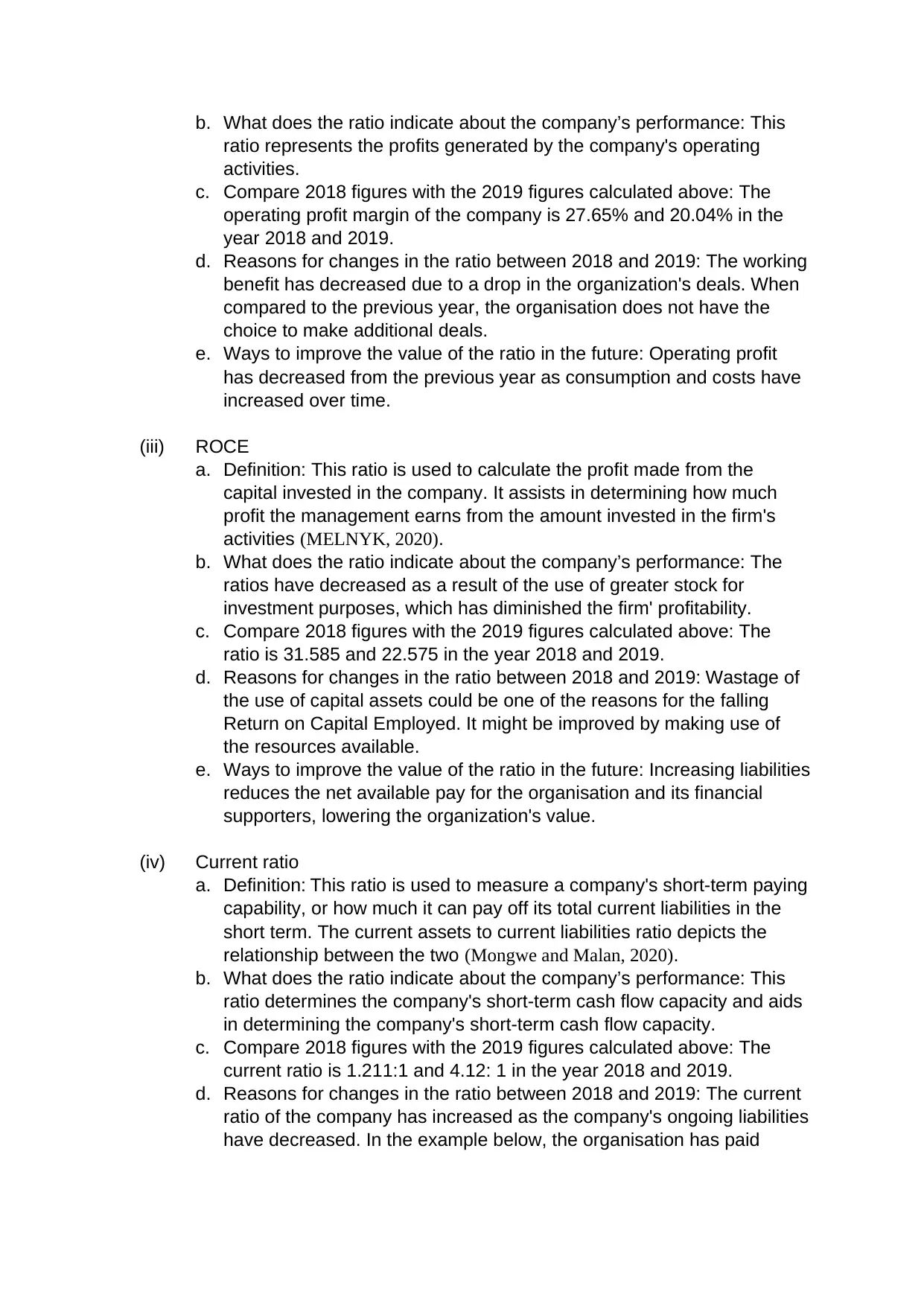
b. What does the ratio indicate about the company’s performance: This
ratio represents the profits generated by the company's operating
activities.
c. Compare 2018 figures with the 2019 figures calculated above: The
operating profit margin of the company is 27.65% and 20.04% in the
year 2018 and 2019.
d. Reasons for changes in the ratio between 2018 and 2019: The working
benefit has decreased due to a drop in the organization's deals. When
compared to the previous year, the organisation does not have the
choice to make additional deals.
e. Ways to improve the value of the ratio in the future: Operating profit
has decreased from the previous year as consumption and costs have
increased over time.
(iii) ROCE
a. Definition: This ratio is used to calculate the profit made from the
capital invested in the company. It assists in determining how much
profit the management earns from the amount invested in the firm's
activities (MELNYK, 2020).
b. What does the ratio indicate about the company’s performance: The
ratios have decreased as a result of the use of greater stock for
investment purposes, which has diminished the firm' profitability.
c. Compare 2018 figures with the 2019 figures calculated above: The
ratio is 31.585 and 22.575 in the year 2018 and 2019.
d. Reasons for changes in the ratio between 2018 and 2019: Wastage of
the use of capital assets could be one of the reasons for the falling
Return on Capital Employed. It might be improved by making use of
the resources available.
e. Ways to improve the value of the ratio in the future: Increasing liabilities
reduces the net available pay for the organisation and its financial
supporters, lowering the organization's value.
(iv) Current ratio
a. Definition: This ratio is used to measure a company's short-term paying
capability, or how much it can pay off its total current liabilities in the
short term. The current assets to current liabilities ratio depicts the
relationship between the two (Mongwe and Malan, 2020).
b. What does the ratio indicate about the company’s performance: This
ratio determines the company's short-term cash flow capacity and aids
in determining the company's short-term cash flow capacity.
c. Compare 2018 figures with the 2019 figures calculated above: The
current ratio is 1.211:1 and 4.12: 1 in the year 2018 and 2019.
d. Reasons for changes in the ratio between 2018 and 2019: The current
ratio of the company has increased as the company's ongoing liabilities
have decreased. In the example below, the organisation has paid
ratio represents the profits generated by the company's operating
activities.
c. Compare 2018 figures with the 2019 figures calculated above: The
operating profit margin of the company is 27.65% and 20.04% in the
year 2018 and 2019.
d. Reasons for changes in the ratio between 2018 and 2019: The working
benefit has decreased due to a drop in the organization's deals. When
compared to the previous year, the organisation does not have the
choice to make additional deals.
e. Ways to improve the value of the ratio in the future: Operating profit
has decreased from the previous year as consumption and costs have
increased over time.
(iii) ROCE
a. Definition: This ratio is used to calculate the profit made from the
capital invested in the company. It assists in determining how much
profit the management earns from the amount invested in the firm's
activities (MELNYK, 2020).
b. What does the ratio indicate about the company’s performance: The
ratios have decreased as a result of the use of greater stock for
investment purposes, which has diminished the firm' profitability.
c. Compare 2018 figures with the 2019 figures calculated above: The
ratio is 31.585 and 22.575 in the year 2018 and 2019.
d. Reasons for changes in the ratio between 2018 and 2019: Wastage of
the use of capital assets could be one of the reasons for the falling
Return on Capital Employed. It might be improved by making use of
the resources available.
e. Ways to improve the value of the ratio in the future: Increasing liabilities
reduces the net available pay for the organisation and its financial
supporters, lowering the organization's value.
(iv) Current ratio
a. Definition: This ratio is used to measure a company's short-term paying
capability, or how much it can pay off its total current liabilities in the
short term. The current assets to current liabilities ratio depicts the
relationship between the two (Mongwe and Malan, 2020).
b. What does the ratio indicate about the company’s performance: This
ratio determines the company's short-term cash flow capacity and aids
in determining the company's short-term cash flow capacity.
c. Compare 2018 figures with the 2019 figures calculated above: The
current ratio is 1.211:1 and 4.12: 1 in the year 2018 and 2019.
d. Reasons for changes in the ratio between 2018 and 2019: The current
ratio of the company has increased as the company's ongoing liabilities
have decreased. In the example below, the organisation has paid
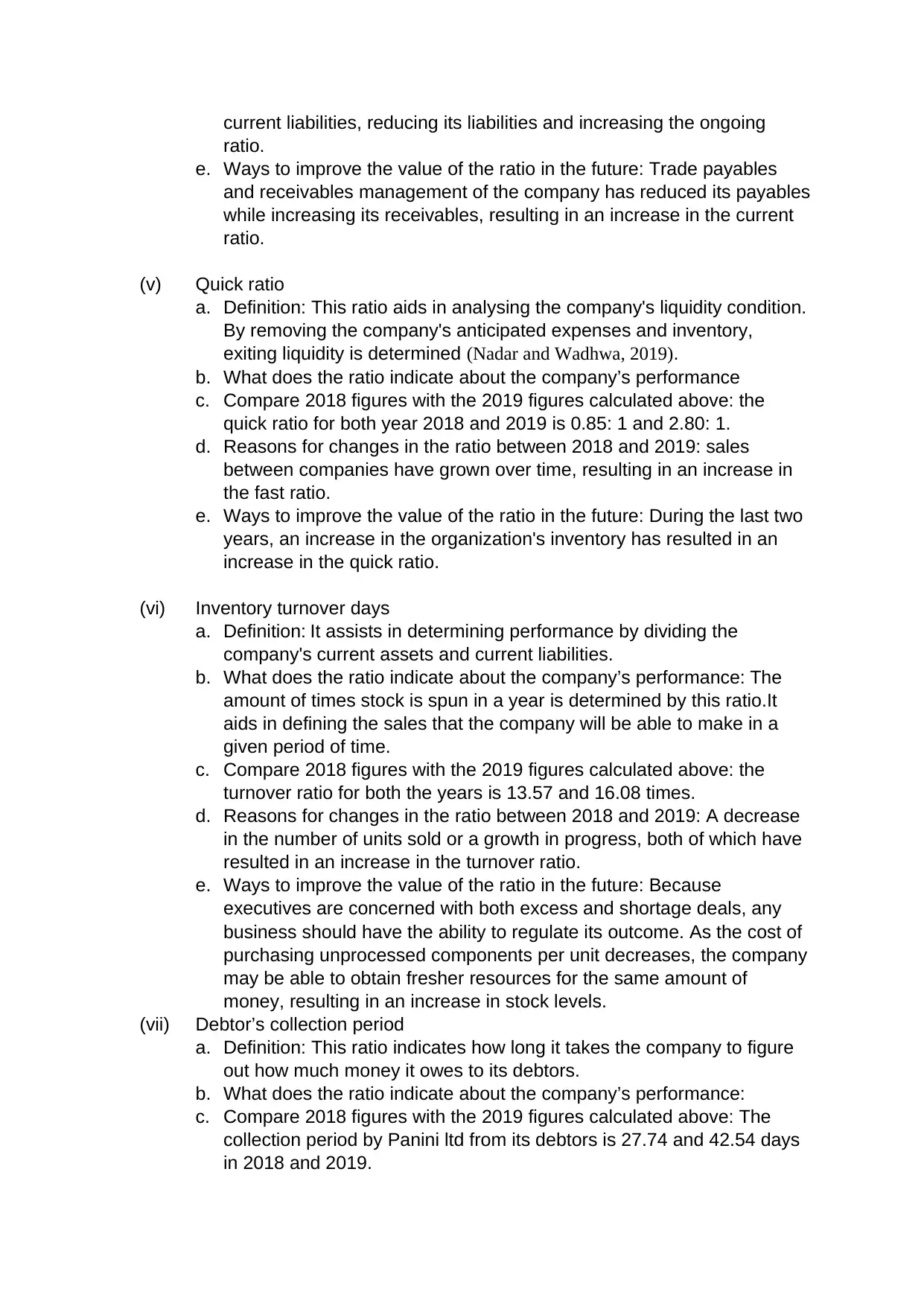
current liabilities, reducing its liabilities and increasing the ongoing
ratio.
e. Ways to improve the value of the ratio in the future: Trade payables
and receivables management of the company has reduced its payables
while increasing its receivables, resulting in an increase in the current
ratio.
(v) Quick ratio
a. Definition: This ratio aids in analysing the company's liquidity condition.
By removing the company's anticipated expenses and inventory,
exiting liquidity is determined (Nadar and Wadhwa, 2019).
b. What does the ratio indicate about the company’s performance
c. Compare 2018 figures with the 2019 figures calculated above: the
quick ratio for both year 2018 and 2019 is 0.85: 1 and 2.80: 1.
d. Reasons for changes in the ratio between 2018 and 2019: sales
between companies have grown over time, resulting in an increase in
the fast ratio.
e. Ways to improve the value of the ratio in the future: During the last two
years, an increase in the organization's inventory has resulted in an
increase in the quick ratio.
(vi) Inventory turnover days
a. Definition: It assists in determining performance by dividing the
company's current assets and current liabilities.
b. What does the ratio indicate about the company’s performance: The
amount of times stock is spun in a year is determined by this ratio.It
aids in defining the sales that the company will be able to make in a
given period of time.
c. Compare 2018 figures with the 2019 figures calculated above: the
turnover ratio for both the years is 13.57 and 16.08 times.
d. Reasons for changes in the ratio between 2018 and 2019: A decrease
in the number of units sold or a growth in progress, both of which have
resulted in an increase in the turnover ratio.
e. Ways to improve the value of the ratio in the future: Because
executives are concerned with both excess and shortage deals, any
business should have the ability to regulate its outcome. As the cost of
purchasing unprocessed components per unit decreases, the company
may be able to obtain fresher resources for the same amount of
money, resulting in an increase in stock levels.
(vii) Debtor’s collection period
a. Definition: This ratio indicates how long it takes the company to figure
out how much money it owes to its debtors.
b. What does the ratio indicate about the company’s performance:
c. Compare 2018 figures with the 2019 figures calculated above: The
collection period by Panini ltd from its debtors is 27.74 and 42.54 days
in 2018 and 2019.
ratio.
e. Ways to improve the value of the ratio in the future: Trade payables
and receivables management of the company has reduced its payables
while increasing its receivables, resulting in an increase in the current
ratio.
(v) Quick ratio
a. Definition: This ratio aids in analysing the company's liquidity condition.
By removing the company's anticipated expenses and inventory,
exiting liquidity is determined (Nadar and Wadhwa, 2019).
b. What does the ratio indicate about the company’s performance
c. Compare 2018 figures with the 2019 figures calculated above: the
quick ratio for both year 2018 and 2019 is 0.85: 1 and 2.80: 1.
d. Reasons for changes in the ratio between 2018 and 2019: sales
between companies have grown over time, resulting in an increase in
the fast ratio.
e. Ways to improve the value of the ratio in the future: During the last two
years, an increase in the organization's inventory has resulted in an
increase in the quick ratio.
(vi) Inventory turnover days
a. Definition: It assists in determining performance by dividing the
company's current assets and current liabilities.
b. What does the ratio indicate about the company’s performance: The
amount of times stock is spun in a year is determined by this ratio.It
aids in defining the sales that the company will be able to make in a
given period of time.
c. Compare 2018 figures with the 2019 figures calculated above: the
turnover ratio for both the years is 13.57 and 16.08 times.
d. Reasons for changes in the ratio between 2018 and 2019: A decrease
in the number of units sold or a growth in progress, both of which have
resulted in an increase in the turnover ratio.
e. Ways to improve the value of the ratio in the future: Because
executives are concerned with both excess and shortage deals, any
business should have the ability to regulate its outcome. As the cost of
purchasing unprocessed components per unit decreases, the company
may be able to obtain fresher resources for the same amount of
money, resulting in an increase in stock levels.
(vii) Debtor’s collection period
a. Definition: This ratio indicates how long it takes the company to figure
out how much money it owes to its debtors.
b. What does the ratio indicate about the company’s performance:
c. Compare 2018 figures with the 2019 figures calculated above: The
collection period by Panini ltd from its debtors is 27.74 and 42.54 days
in 2018 and 2019.
⊘ This is a preview!⊘
Do you want full access?
Subscribe today to unlock all pages.

Trusted by 1+ million students worldwide
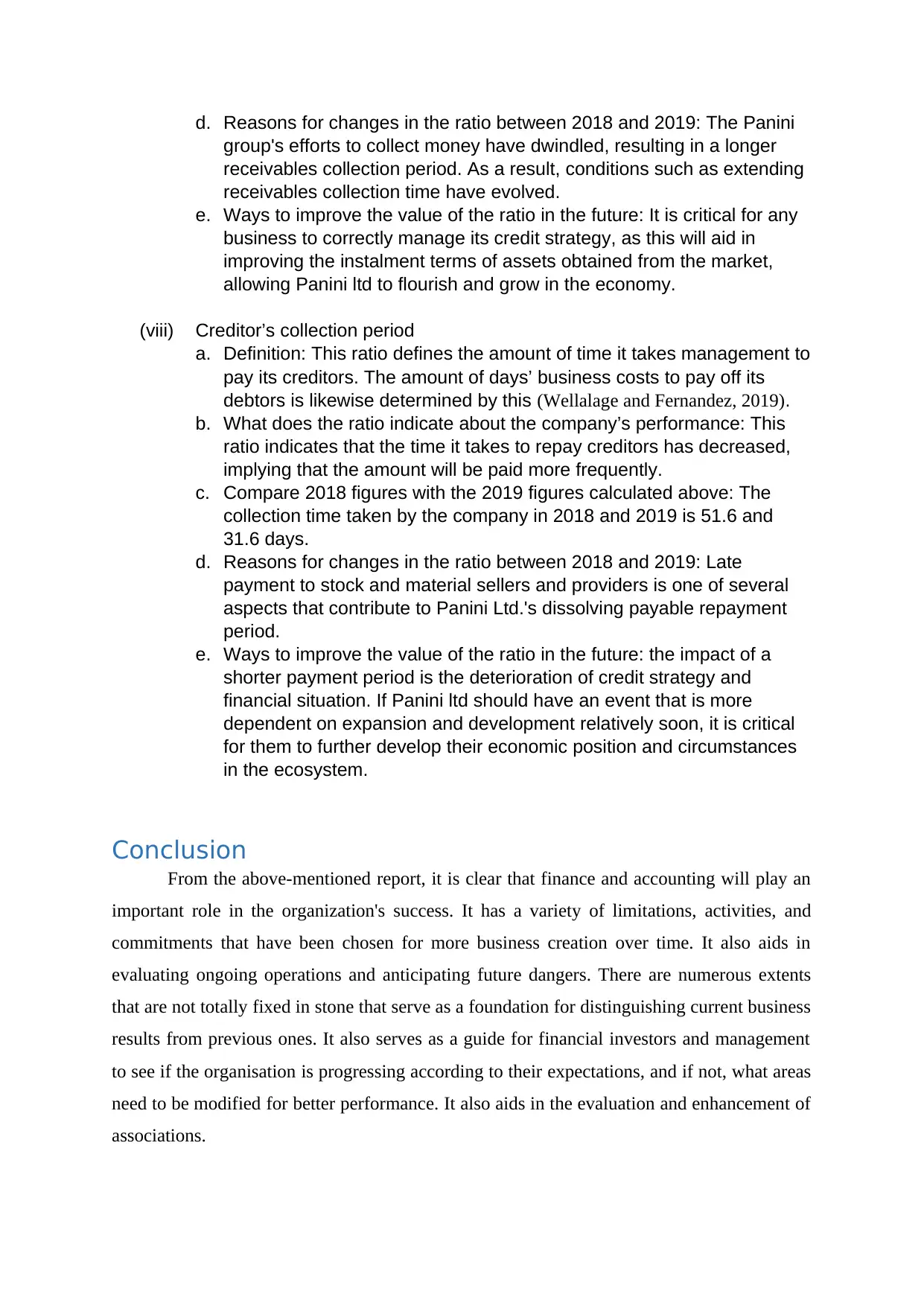
d. Reasons for changes in the ratio between 2018 and 2019: The Panini
group's efforts to collect money have dwindled, resulting in a longer
receivables collection period. As a result, conditions such as extending
receivables collection time have evolved.
e. Ways to improve the value of the ratio in the future: It is critical for any
business to correctly manage its credit strategy, as this will aid in
improving the instalment terms of assets obtained from the market,
allowing Panini ltd to flourish and grow in the economy.
(viii) Creditor’s collection period
a. Definition: This ratio defines the amount of time it takes management to
pay its creditors. The amount of days’ business costs to pay off its
debtors is likewise determined by this (Wellalage and Fernandez, 2019).
b. What does the ratio indicate about the company’s performance: This
ratio indicates that the time it takes to repay creditors has decreased,
implying that the amount will be paid more frequently.
c. Compare 2018 figures with the 2019 figures calculated above: The
collection time taken by the company in 2018 and 2019 is 51.6 and
31.6 days.
d. Reasons for changes in the ratio between 2018 and 2019: Late
payment to stock and material sellers and providers is one of several
aspects that contribute to Panini Ltd.'s dissolving payable repayment
period.
e. Ways to improve the value of the ratio in the future: the impact of a
shorter payment period is the deterioration of credit strategy and
financial situation. If Panini ltd should have an event that is more
dependent on expansion and development relatively soon, it is critical
for them to further develop their economic position and circumstances
in the ecosystem.
Conclusion
From the above-mentioned report, it is clear that finance and accounting will play an
important role in the organization's success. It has a variety of limitations, activities, and
commitments that have been chosen for more business creation over time. It also aids in
evaluating ongoing operations and anticipating future dangers. There are numerous extents
that are not totally fixed in stone that serve as a foundation for distinguishing current business
results from previous ones. It also serves as a guide for financial investors and management
to see if the organisation is progressing according to their expectations, and if not, what areas
need to be modified for better performance. It also aids in the evaluation and enhancement of
associations.
group's efforts to collect money have dwindled, resulting in a longer
receivables collection period. As a result, conditions such as extending
receivables collection time have evolved.
e. Ways to improve the value of the ratio in the future: It is critical for any
business to correctly manage its credit strategy, as this will aid in
improving the instalment terms of assets obtained from the market,
allowing Panini ltd to flourish and grow in the economy.
(viii) Creditor’s collection period
a. Definition: This ratio defines the amount of time it takes management to
pay its creditors. The amount of days’ business costs to pay off its
debtors is likewise determined by this (Wellalage and Fernandez, 2019).
b. What does the ratio indicate about the company’s performance: This
ratio indicates that the time it takes to repay creditors has decreased,
implying that the amount will be paid more frequently.
c. Compare 2018 figures with the 2019 figures calculated above: The
collection time taken by the company in 2018 and 2019 is 51.6 and
31.6 days.
d. Reasons for changes in the ratio between 2018 and 2019: Late
payment to stock and material sellers and providers is one of several
aspects that contribute to Panini Ltd.'s dissolving payable repayment
period.
e. Ways to improve the value of the ratio in the future: the impact of a
shorter payment period is the deterioration of credit strategy and
financial situation. If Panini ltd should have an event that is more
dependent on expansion and development relatively soon, it is critical
for them to further develop their economic position and circumstances
in the ecosystem.
Conclusion
From the above-mentioned report, it is clear that finance and accounting will play an
important role in the organization's success. It has a variety of limitations, activities, and
commitments that have been chosen for more business creation over time. It also aids in
evaluating ongoing operations and anticipating future dangers. There are numerous extents
that are not totally fixed in stone that serve as a foundation for distinguishing current business
results from previous ones. It also serves as a guide for financial investors and management
to see if the organisation is progressing according to their expectations, and if not, what areas
need to be modified for better performance. It also aids in the evaluation and enhancement of
associations.
Paraphrase This Document
Need a fresh take? Get an instant paraphrase of this document with our AI Paraphraser

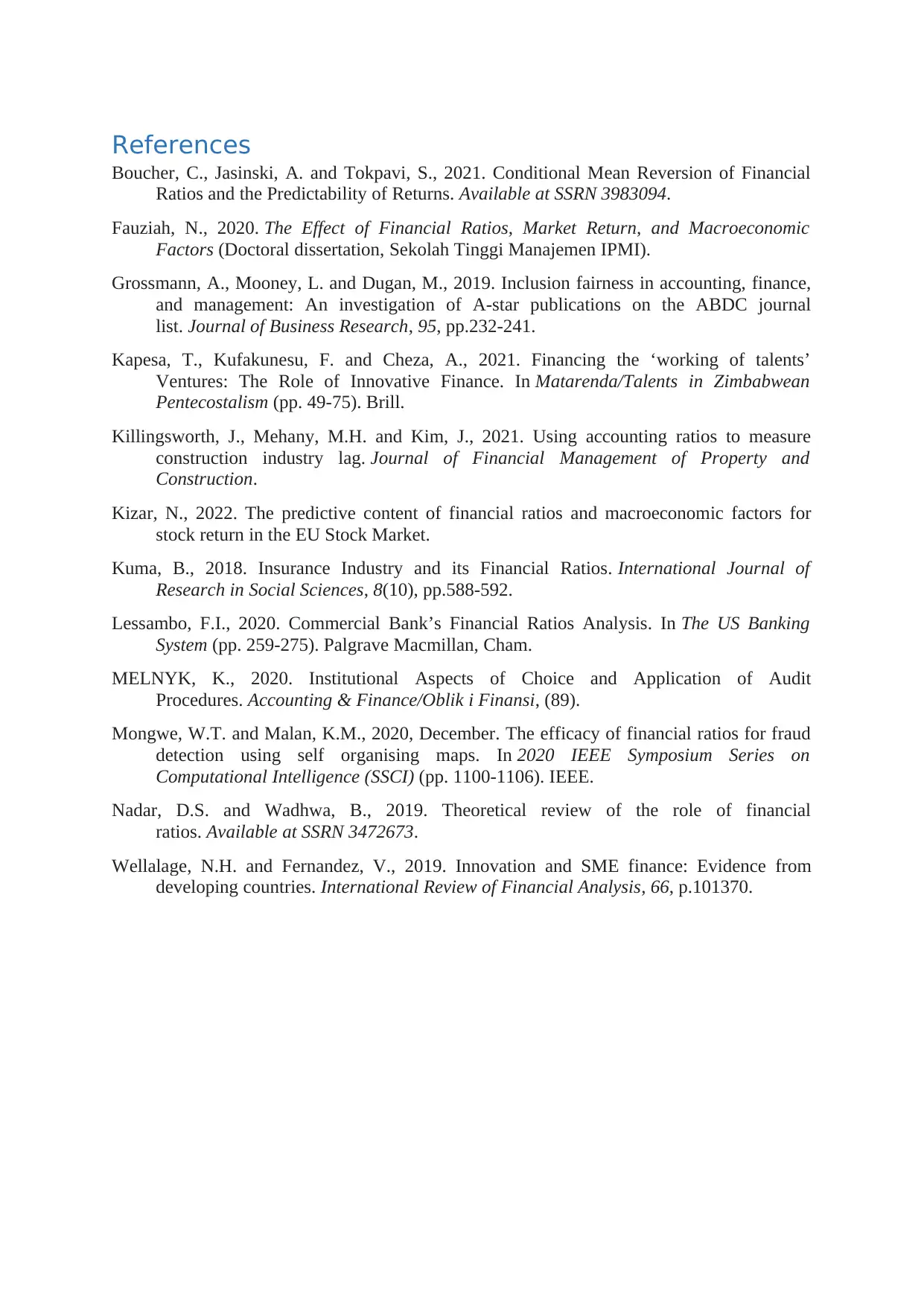
References
Boucher, C., Jasinski, A. and Tokpavi, S., 2021. Conditional Mean Reversion of Financial
Ratios and the Predictability of Returns. Available at SSRN 3983094.
Fauziah, N., 2020. The Effect of Financial Ratios, Market Return, and Macroeconomic
Factors (Doctoral dissertation, Sekolah Tinggi Manajemen IPMI).
Grossmann, A., Mooney, L. and Dugan, M., 2019. Inclusion fairness in accounting, finance,
and management: An investigation of A-star publications on the ABDC journal
list. Journal of Business Research, 95, pp.232-241.
Kapesa, T., Kufakunesu, F. and Cheza, A., 2021. Financing the ‘working of talents’
Ventures: The Role of Innovative Finance. In Matarenda/Talents in Zimbabwean
Pentecostalism (pp. 49-75). Brill.
Killingsworth, J., Mehany, M.H. and Kim, J., 2021. Using accounting ratios to measure
construction industry lag. Journal of Financial Management of Property and
Construction.
Kizar, N., 2022. The predictive content of financial ratios and macroeconomic factors for
stock return in the EU Stock Market.
Kuma, B., 2018. Insurance Industry and its Financial Ratios. International Journal of
Research in Social Sciences, 8(10), pp.588-592.
Lessambo, F.I., 2020. Commercial Bank’s Financial Ratios Analysis. In The US Banking
System (pp. 259-275). Palgrave Macmillan, Cham.
MELNYK, K., 2020. Institutional Aspects of Choice and Application of Audit
Procedures. Accounting & Finance/Oblik i Finansi, (89).
Mongwe, W.T. and Malan, K.M., 2020, December. The efficacy of financial ratios for fraud
detection using self organising maps. In 2020 IEEE Symposium Series on
Computational Intelligence (SSCI) (pp. 1100-1106). IEEE.
Nadar, D.S. and Wadhwa, B., 2019. Theoretical review of the role of financial
ratios. Available at SSRN 3472673.
Wellalage, N.H. and Fernandez, V., 2019. Innovation and SME finance: Evidence from
developing countries. International Review of Financial Analysis, 66, p.101370.
Boucher, C., Jasinski, A. and Tokpavi, S., 2021. Conditional Mean Reversion of Financial
Ratios and the Predictability of Returns. Available at SSRN 3983094.
Fauziah, N., 2020. The Effect of Financial Ratios, Market Return, and Macroeconomic
Factors (Doctoral dissertation, Sekolah Tinggi Manajemen IPMI).
Grossmann, A., Mooney, L. and Dugan, M., 2019. Inclusion fairness in accounting, finance,
and management: An investigation of A-star publications on the ABDC journal
list. Journal of Business Research, 95, pp.232-241.
Kapesa, T., Kufakunesu, F. and Cheza, A., 2021. Financing the ‘working of talents’
Ventures: The Role of Innovative Finance. In Matarenda/Talents in Zimbabwean
Pentecostalism (pp. 49-75). Brill.
Killingsworth, J., Mehany, M.H. and Kim, J., 2021. Using accounting ratios to measure
construction industry lag. Journal of Financial Management of Property and
Construction.
Kizar, N., 2022. The predictive content of financial ratios and macroeconomic factors for
stock return in the EU Stock Market.
Kuma, B., 2018. Insurance Industry and its Financial Ratios. International Journal of
Research in Social Sciences, 8(10), pp.588-592.
Lessambo, F.I., 2020. Commercial Bank’s Financial Ratios Analysis. In The US Banking
System (pp. 259-275). Palgrave Macmillan, Cham.
MELNYK, K., 2020. Institutional Aspects of Choice and Application of Audit
Procedures. Accounting & Finance/Oblik i Finansi, (89).
Mongwe, W.T. and Malan, K.M., 2020, December. The efficacy of financial ratios for fraud
detection using self organising maps. In 2020 IEEE Symposium Series on
Computational Intelligence (SSCI) (pp. 1100-1106). IEEE.
Nadar, D.S. and Wadhwa, B., 2019. Theoretical review of the role of financial
ratios. Available at SSRN 3472673.
Wellalage, N.H. and Fernandez, V., 2019. Innovation and SME finance: Evidence from
developing countries. International Review of Financial Analysis, 66, p.101370.
⊘ This is a preview!⊘
Do you want full access?
Subscribe today to unlock all pages.

Trusted by 1+ million students worldwide
1 out of 12
Related Documents
Your All-in-One AI-Powered Toolkit for Academic Success.
+13062052269
info@desklib.com
Available 24*7 on WhatsApp / Email
![[object Object]](/_next/static/media/star-bottom.7253800d.svg)
Unlock your academic potential
Copyright © 2020–2025 A2Z Services. All Rights Reserved. Developed and managed by ZUCOL.

